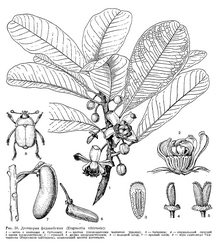Degeneria vitiensis
 From Wikipedia the free encyclopedia
From Wikipedia the free encyclopedia
| Degeneria vitiensis | |
|---|---|
 | |
| Scientific classification | |
| Kingdom: | Plantae |
| Clade: | Tracheophytes |
| Clade: | Angiosperms |
| Clade: | Magnoliids |
| Order: | Magnoliales |
| Family: | Degeneriaceae |
| Genus: | Degeneria |
| Species: | D. vitiensis |
| Binomial name | |
| Degeneria vitiensis L.W.Bailey & A.C.Sm. | |
Degeneria vitiensis is a flowering tree found on Viti Levu in Fiji.[2] It is known as masiratu and vāvāloa in Fijian, although the latter is also used for Litsea magnifolia.[3] It is a relatively common plant and is used as timber. It has been found in upland forests on steep slopes.[4]
The pollen-eating beetle Haptoncus takhtajani is associated with the plant.[5][6][7] The systematics and taxonomy of Degeneriaceae were reviewed in 1991.[8]
References
[edit]- ^ Masau, M. (2016). "Degeneria vitiensis". IUCN Red List of Threatened Species. 2016: e.T32005A99515555. doi:10.2305/IUCN.UK.2016-3.RLTS.T32005A99515555.en. Retrieved 19 November 2021.
- ^ "Degeneria vitiensis - L.W.Bailey & A.C.Sm". Plants of the World Online. Retrieved 2 April 2021.
- ^ Gatty, Ronald (2009). Fijian-English Dictionary (with notes on Fijian culture and natural history). Suva, Fiji: Ronald Gatty. p. 159. ISBN 978-982-98047-1-6.
- ^ "Magnoliales | Definition, Taxonomy, Morphology, Evolution, & Facts | Britannica". Encyclopaedia Britannica. Retrieved 2022-09-13.
- ^ Miller, J. M. 1988. A new species of Degeneria (Degeneriaceae) from Fiji Archipelago. Journal of the Arnold Arboretum 69: 275–280
- ^ Miller, J. M. 1988. Puzzling new floral variation in a possible Mesozoic relict flowering plant, Fiji Islands. P. 4, In: H. J. de Blij (ed.), Letters, National Geographic Research Volume 4. Washington, D. C.: National Geographic Society, 144 pp.
- ^ Miller, J. M. 1989. The archaic flowering plant family Degeneriaceae: its bearing on an old enigma. National Geographic Research 5(2): 218–231.
- ^ Smith, A. C. 1991. Degeneriaceae Pp. 587-588 In: A. C. Smith, Flora Vitiensis Nova, Volume 5. Lawai: National Tropical Botanical Garden, 626 pp.
